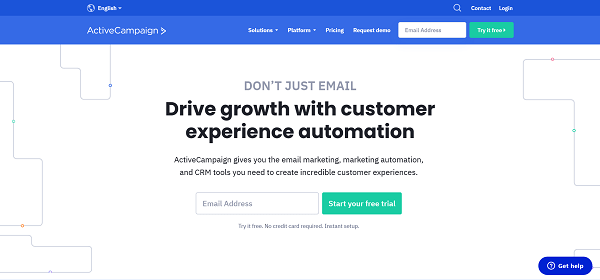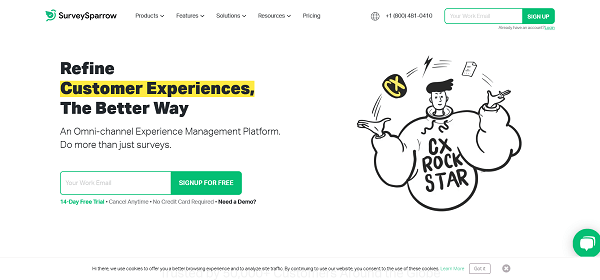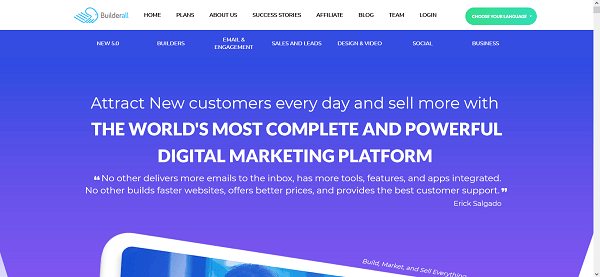
By Dave Carr @Review.Casa
This website is reader-supported. When you buy through links on the site, I may earn an affiliate commission.
Table of Contents
What is a chatbot?
A chatbot is a computer program designed to simulate conversation with human users. Chatbots are used in a variety of settings, including online customer service, online shopping, and online gaming. They can also be used to provide information about products and services, or to promote other online content.
Chatbots are typically designed to mimic human conversation, using natural language processing to understand what users are saying. In some cases, chatbots may also use artificial intelligence to generate responses.
Chatbots are a good way of automating interactions with your visitors and trying to cut down on support requests. Most chatbots will be activated when they pick up keywords or phrases that are typed into the chat box on your website.
One of the most popular chatbots is SurveySparrow. SurveySparrow is designed to chat with users on a variety of topics.
Chatbots are becoming increasingly popular as a way to interact with users online. Many companies are now using chatbots to provide customer service, and some chatbots are even able to make online purchases on behalf of users.
How do chatbots work?
Chatbots work by taking in input from a user and then providing a response based on that input. The response can be based on predefined rules or it can be generated by artificial intelligence.
The most common type of chatbot is the rule-based chatbot. These chatbots follow a set of rules in order to generate a response. The rules are defined by the chatbot developer and can be changed at any time.
Rule-based chatbots can be very simple, only providing basic responses to user input or they can be more complex, providing more detailed responses and even carrying on a conversation with the user.
Artificial intelligence chatbots are more complex than rule-based chatbots. They use artificial intelligence algorithms to generate responses. This means that they can understand the user input and respond in a more natural way.
Artificial intelligence chatbots are more difficult to develop than rule-based chatbots. But they can provide a more human-like experience to the user.
The benefits of chatbots in retail customer insight
In the last few years, chatbots have become increasingly popular in the customer service industry. And it’s no wonder why. Chatbots offer a number of advantages over traditional customer service methods, such as phone and email support.
For starters, chatbots are available 24/7. This means that they can provide assistance to customers at any time of the day or night, regardless of time zone differences.
Another advantage of chatbots is that they can handle multiple tasks simultaneously. This means that they can provide support for multiple customers at the same time, something that is not possible with traditional customer service methods.
Another advantage of chatbots is that they can offer a more personalized experience to customers. This is because chatbots can remember customer preferences and history, and use this information to provide tailored recommendations and support.
Finally, chatbots can help businesses to save money. This is because they can automate many customer service tasks, such as handling customer queries and providing support. This can free up customer service agents to focus on more complex tasks, such as problem solving.
In short, chatbots offer a number of advantages over traditional customer service methods. And as the technology continues to develop, it is likely that chatbots will become even more popular in the customer service industry.
Here are 4 platforms that allow you to add chatbots to your website.
Typeform

Typeform is an online form builder which allows you to create surveys, polls, quizzes, tests and chatbots.
Typeform’s software has been used by Apple Inc., Airbnb, Uber and Nike so if you are looking for a way to gather user feedback without all the features of an all in one marketing platform then Typeform might just be the right solution for you.
ActiveCampaign

ActiveCampaign offers an optional extra service called ActiveCampaign conversations which adds Chat, Email, Automated Chatbot Workflows, Unified Inbox, Reporting and Chat Transcripts, Agent Assignments for Inbound and Facebook Messenger Service Channels to whichever package you are on.
If you’re looking for an all in one platform to run your business then ActiveCampaign will have every conceivable feature you would need but the cost can soon add up.
SurveySparrow

It’s a popular platform mainly targeted at businesses.
If you are looking to add chatbots to your website then SurveySparrow could be the platform you’re after.
Builderall

If you’re looking for a suite of marketing tools then Builderall could have everything you’re looking for.
The challenges of chatbots.
The challenges of chatbots are many and varied. They include everything from the technical challenges of building a chatbot to the more human challenges of making a chatbot seem like a real person.
One of the biggest challenges of chatbots is making them seem lifelike. This is especially difficult when the chatbot is supposed to be representing a real person, such as a customer service representative. The challenge is to make the chatbot seem like a real person without making it seem like a robot.
Another challenge of chatbots is making them understand natural language. This is a difficult task for any computer, but it is made even more difficult when the chatbot has to understand the nuances of human conversation.
A further challenge of chatbots is making them engaging. A chatbot that is not engaging is likely to be ignored by users. This is a particular problem when the chatbot is supposed to be used for customer service, as users are likely to be impatient if they feel they are talking to a machine.
Finally, chatbots also have to deal with the issue of trust. Users need to trust that the chatbot is not going to misuse their personal information or do anything that could harm them. This is a difficult issue to address, as it is hard to create a chatbot that is both trustworthy and lifelike.
The future of chatbots
As digital assistants become more commonplace, it’s likely that chatbots will become more prevalent as well. Currently, chatbots are used mostly for customer service or basic tasks such as setting appointments and providing weather forecasts.
However, as artificial intelligence (AI) technology continues to evolve, chatbots will become increasingly capable of handling more complex tasks.
It’s possible that chatbots will eventually replace many human jobs, such as customer service representatives and data entry clerks.
Chatbots can already handle simple requests and questions, so it’s not a far stretch to imagine them taking on more complicated tasks. As chatbots become more advanced, businesses will likely increasingly rely on them to handle a variety of tasks, freeing up human employees to focus on more critical tasks.
In the future, chatbots may also be used to provide more personalised services. For example, a chatbot could be used to recommend products or services to customers based on their individual preferences.
Chatbots could also be used to provide tailored advice or support, such as helping people quit smoking or lose weight.
Overall, chatbots are likely to play an increasingly important role in our lives in the future.
They have the potential to greatly improve efficiency and productivity and to personalise our experiences in a way that human employees simply cannot.
As chatbots continue to evolve, it will be interesting to see how they change the way we live and work.








